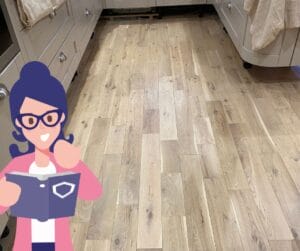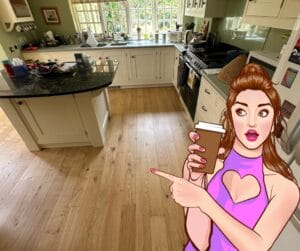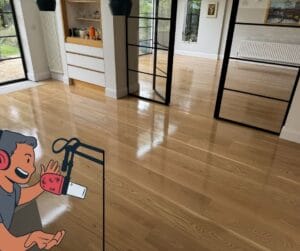Hi there, and welcome to our latest blog, “How to Protect Wood Floors from damage in Cambridgeshire.” If you’re a regular reader, welcome back! We truly appreciate your continued support and love having you here. If this is your first visit, we hope you enjoy the article and find it packed with useful tips to keep your wood floors looking their best.
Let’s jump right in now!
Wood floors bring warmth, elegance, and timeless beauty to your home, but they’re not invincible. Over time, foot traffic, furniture movement, and the presence of pets can cause scratches and scuffs that dull their charm. From the sharp stiletto heel to the playful claws of a furry friend, there are plenty of ways your floors might end up with marks. But don’t worry! With a few preventative measures and an understanding of the challenges, you can keep your floors looking pristine for years to come.



Why Do Scratches and Scuffs Happen?
Everyday wear and tear
Wood floors are a natural choice for homeowners across Cambridgeshire because of their durability and aesthetic appeal. However, they’re not immune to the effects of daily life. Foot traffic, especially in high-use areas like hallways and living rooms, can lead to scuff marks. Over time, even tiny particles of dirt trapped on shoes can act like sandpaper, wearing away the finish.
Furniture movement
Rearranging furniture or simply sliding chairs back from the dining table can lead to scratches. Heavy items like sofas or wardrobes can dig into the surface if not handled carefully.
Pets and their playful nature
If you have pets, you’re probably familiar with how their claws can leave marks. Even the most well-behaved pet can occasionally skid or scratch the surface while chasing a toy or greeting visitors.
Heels and dragging objects
High heels, with their concentrated pressure, can dent or scratch wood floors. Similarly, dragging objects like boxes or heavy appliances can cause long, unsightly marks.
Challenges You’ll Face Trying to Protect Wood Floors From Damage in Cambridgeshire
While prevention sounds simple, life doesn’t always cooperate. For homeowners in Cambridgeshire, here are some common challenges to be aware of:
- Busy lifestyles
With work, family, and pets to manage, keeping on top of maintenance might feel like an extra chore.
- Furniture placement in smaller spaces
If your home is on the cosier side, frequent furniture movement might be unavoidable when making room for guests or reconfiguring the space.
- Older floors
Older wood floors in need of restoration are more vulnerable to scratches because their protective finish may have worn away over time.
- Lack of protective measures
Sometimes, it’s simply a matter of not knowing the small, inexpensive steps that can make a big difference.
How to Protect Wood Floors From Damage in Cambridgeshire
Luckily, there are many ways to minimise the risk of damage to your wood floors. Here are some homeowner-friendly tips:
1. Invest in Rugs and Mats
Place rugs in high-traffic areas such as entrances, hallways, and living rooms to reduce the impact of foot traffic. Choose mats with a non-slip backing to keep them securely in place.
2. Use Furniture Pads
Stick felt or rubber pads to the bottom of furniture legs to stop scratches when moving or adjusting pieces. They’re not expensive and easy to install, making them a no-brainer for wood floor protection.
3. Keep Floors Clean
Sweeping and vacuuming your wood floors regularly helps remove dirt that can damage the surface. Use a soft-bristle brush or vacuum attachment specifically designed for wood floors.
4. Trim Pet Nails
If you have pets, keep their nails trimmed to reduce the risk of scratches. You can also use rugs in areas where your pets are most active to create a protective barrier.
5. Avoid Dragging Heavy Items
When moving furniture or appliances, lift them rather than drag them. If lifting isn’t an option, place a protective layer, like a towel or moving blanket, under the item before sliding it.
6. Take Off Shoes Indoors
Encourage your family and guests to take their shoes off before stepping onto the wood floors. Provide a shoe rack or storage space near the entrance to make this easy.
7. Maintain the Finish
If your floor’s finish is wearing thin, it’s time to think about professional wood floor restoration. A fresh finish provides a protective barrier against scratches and scuffs, keeping your floor looking its best.
Why Wood Floor Restoration Matters in Cambridgeshire
Even with the best preventative measures, some scratches and scuffs are inevitable. That’s where professional wood floor restoration comes in. For homeowners in Cambridgeshire, this process can bring even the most tired and scratched floors back to life. Restoration involves sanding down the damaged surface, applying a primer, and finishing with a durable sealant.
This improves the appearance of your floors and also extends their lifespan, making it a worthwhile investment for your home. Whether you’re dealing with scratches caused by years of use or want to prepare your floors for the future, restoration is the key to preserving their beauty.
A Final Word of Advice
Caring for your wood floors doesn’t have to be complicated. With a mix of preventative measures and professional support when needed, you can enjoy beautiful, scratch-free floors for years. And if you’re in Cambridgeshire and looking for expert advice or wood floor restoration, don’t hesitate to reach out. Whether it’s a small scuff or a full-scale refresh, there’s always a solution to keep your floors in top shape.
Your floors are an investment—protect them well, and they’ll reward you with lasting beauty and durability.
Check out our Process from our wood team in action:


















